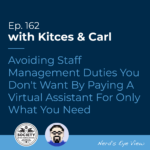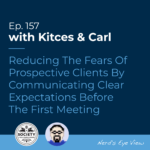
Hiring a contractor is an exciting step for many advisory firms. It represents a chance to delegate tasks, step away from day-to-day operations with more peace of mind, and pass a key milestone of (traditional) firm growth. However, hiring contractors isn’t without its complications. Even outsourced support requires some oversight, and delegation doesn’t always go as far as some might hope. So, how can advisors best leverage contractors, and how can they evaluate the value of such work (especially against the prospect of hiring a full-time employee)?
In the 162nd episode of Kitces and Carl, Michael Kitces and client communication expert Carl Richards explore how to master delegation, measure success with contractors, and weigh the cost of outsourcing versus hiring full-time to determine what’s actually ‘reasonable’.
Before an advisor can truly evaluate a contractor’s value, they must challenge themselves by looking inward. Delegation can be deceptive: Advisors may believe they’ve delegated more than they have, or that tasks only they can do are more essential than they really are. Taking time to interrogate those assumptions – by asking what can be delegated or even eliminated – can help free up more time than expected.
From there, an advisor can focus more on the art of delegating well. Creating style guides or video tutorials can streamline both training and follow-up questions. Advisors can also use these materials to communicate the firm's values and purpose – both for conveying firm culture and reducing the time advisors need to spend reviewing and correcting work done by others.
Eventually, advisors may wonder if it’s still worthwhile to ‘just’ hire a contractor, or if it’s time to bring on a full-time employee. There are certainly different ways to evaluate the all-in cost of a contractor versus an employee; both approaches will be the ‘right’ answer for different firms depending on the unique circumstances and challenges faced by advisors. While a contractor's hourly rate is often higher, the firm foregoes the additional cost of benefits, downtime, and in-depth people management. In fact, when considering the real cost of a full-time team member – including salary, oversight, and overhead – a contractor can be more cost-effective, especially when an advisor only pays for what they need. And, if an advisor is looking to manage costs more precisely, they may want to segment tasks by outsourcing low-cost work to one contractor and higher-skill work to another – without needing a single full-time hire.
Ultimately, the key point is that outsourced contracting can be a great tool to better leverage and reclaim an advisor’s time – when used well. With thoughtful and continual delegation, clear communication of the firm’s ‘why’ and unique values, and an eye toward iterative improvement, advisors can focus their energy where it’s needed most: on the work that only they can do!











